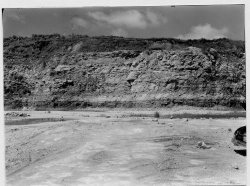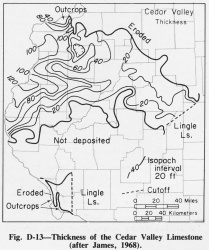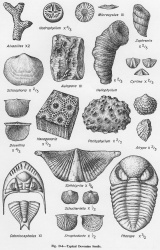Cedar Valley Limestone
Lithostratigraphy: Hunton Limestone Megagroup >>Cedar Valley Limestone
Chronostratigraphy: Paleozoic Erathem >>Devonian System >>Middle Devonian Series
Allostratigraphy: Kaskaskia Sequence
Primary source
Willman, H. B., Elwood Atherton, T. C. Buschbach, Charles Collinson, John C. Frye, M. E. Hopkins, Jerry A. Lineback, and Jack A. Simon, 1975, Handbook of Illinois Stratigraphy: Illinois State Geological Survey Bulletin 95, 261 p.
Contributing author(s)
Charles Collinson and Elwood Atherton
Name
Original description
The Cedar Valley Limestone (McGee, 1891, p. 314).
Derivation
Named for the valley of Cedar River, Iowa.
Other names
History/background
Type section
Type location
No type section has been designated for the Cedar Valley Limestone.
Type author(s)
Type status
Reference section
Reference location
Reference author(s)
Reference status
Stratigraphic relationships
The Cedar Valley Limestone overlies the Wapsipinicon Limestone and underlies the New Albany Shale Group of the Upper Devonian Series. It is exposed in the Rock Island area where the Mississippi River and its tributaries have cut into the Mississippi River Arch (fig. D-3C). Southward, the Cedar Valley overlaps the Wapsipinicon Limestone and thins out on the flank of the Sangamon Arch, except at the northeastern and southwestern ends of the arch where the Middle Devonian seas temporarily covered the arch, and the Cedar Valley sediments are continuous with strata included in the Lingle Limestone. The strata deposited immediately south of the southwestern part of the Sangamon Arch are exposed in Calhoun and Jersey Counties, and, because they are more like the Cedar Valley than the Lingle, the name Cedar Valley has long been used in that area (Rubey, 1952). The Cedar Valley apparently has conformable relations to the Wapsipinicon below. Its sharp erosional contact with the New Albany above indicates a minor unconformity, although the faunal evidence indicates only a brief interruption in sedimentation. In places the Cedar Valley is overlain unconformably by Pennsylvanian strata.
Extent and thickness
The Cedar Valley underlies a large area in north-central and northwestern Illinois (fig. D-13). The Cedar Valley has a maximum thickness of about 130 feet in the subsurface in Hancock County, but it generally thins to the east and south (fig. D-13). It is about 60 feet thick in exposures near Rock Island. In the Calhoun and Jersey County outcrops it is 4-40 feet thick, but in most of the area it is less than 15 feet thick.
Lithology
The Cedar Valley is largely a highly fossiliferous, crystalline, light gray limestone (fig. D-3D), but it contains some fine-grained, argillaceous beds, thin shaly partings, and sandstone. In the northern outcrop area it is subdivided into four members-- the Hoing Sandstone Member at the base, the Solon Member (pure, very fossiliferous), the Rapid Member (argillaceous, partly fossiliferous), and the Coralville Member (pure, very fossiliferous) at the top. In the area south and southwest of Rock Island, the Cedar Valley is medium-grained, detrital limestone that in Hancock and Adams Counties locally contains fine-grained, rounded quartz sand. The Solon and Rapid Members are not differentiated in that area. In the southern outcrop area the Cedar Valley grades from brown, thin-bedded, fine-grained, cherty, argillaceous, sandy limestone at the base to thick-bedded, pure, crystalline, highly fossiliferous limestone in the upper part.
Core(s)
Photograph(s)
Contacts
Well log characteristics
Fossils
The fauna of the Cedar Valley is very large (Savage, 1920, 1921b; Cooper and Cloud, 1938; Rubey, 1952; Collinson and Scott, 1958b; and others) and is characterized by abundant brachiopods and corals (fig. D-6). The Cedar Valley has a large conodont fauna that indicates the Upper Devonian age of the uppermost beds in some areas.
Age and correlation
In general, the fauna correlates the Cedar Valley with Hamilton strata in New York and the upper part of the North Vernon Limestone in Indiana (Collinson et al., 1967b).
Environments of deposition
Economic importance
Remarks
References
COLLINSON, CHARLES, and A. J. SCOTT, 1958b, Chitinozoan faunule of the Devonian Cedar Valley Formation: Illinois State Geological Survey Circular 247, 34 p.
COLLINSON, CHARLES, M. P. CARLSON, F. H. DORHEIM, and J. W. KOENIG, 1967b, Central Iowa Basin, in International symposium on the Devonian System: Alberta Society of Petroleum Geologists, v. 1, p. 963-971; Illinois State Geological Survey Reprint 1968-G.
COOPER, G. A., and P. E. CLOUD, JR., 1938, New Devonian fossils from Calhoun County, Illinois: Journal of Paleontology, v. 12, p. 444-460.
MCGEE, W. J., 1891, Pleistocene history of northeastern Iowa: USGS Annual Report 11, part 1, p. 189-577.
RUBEY, W. W., 1952, Geology and mineral resources of the Hardin and Brussels Quadrangles: USGS Professional Paper 218, 179 p.
SAVAGE, T. E., 1920, Devonian formations of Illinois: American Journal of Science, v. 49, p. 169-182.
SAVAGE, T. E., 1921b, New species of Devonian fossils from western Illinois: Illinois Academy of Science Transactions, v. 14, p. 197-206.
ISGS Codes
| Stratigraphic Code | Geo Unit Designation |
|---|---|



